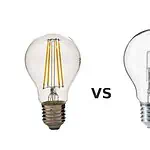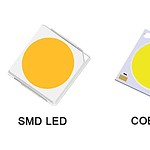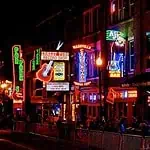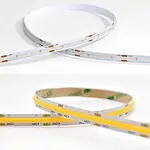You might agree that LEDs have created a buzz in the lighting industry. Earlier, people used halogens and other technologies, which were not so efficient. However, now LEDs have entered and captured most of the market. Sodium vapor bulbs used to be the most energy-efficient in lighting. However, the world has now started switching to LEDs for the most common uses. But that doesn’t mean that people have totally stopped using sodium vapor bulbs.
People prefer LEDs more than sodium vapor bulbs, and there’s a strong reason behind that. LED is a newer technology than sodium bulbs and has several advantages over sodium bulbs. User-friendliness and notable efficiency are some of the primary factors that have made the world fans of LEDs.
Therefore, in this article, you will learn about sodium lamps and LEDs’ pros, cons, and applications. You’ll learn where LEDs and sodium bulbs are used in different scenarios.
High-Pressure Sodium Explained
High-Pressure Sodium (HPS) is the most efficient type of gas discharge light. These lamps have high energy efficiency that emits high luminance over a broad area. Aluminum oxide helps to control the elemental sodium without reacting with it. It also helps to withstand high heat. When you switch on a bulb, the electricity moves to the ignitor. The ignitor sparks the acr, and the bulb starts glowing. After the arc is struck, the lamp appears sky blue as the xenon is ionized. As the temperature rises, mercury vapors tend to ionize. Mercury releases a pale blue to their output, improving the color rendering of the lamp.
The color of the lamp changes due to the different gases produced with a rise in temperatures. With a further rise in temperature, sodium gets ionized. The lamp’s emitted light appears to be a distinctive yellow. Mercury helps to control the rate at which sodium vaporizes. When the temperature inside the arc reaches its peak, the lamp discharges white light. The white light emitted balances a strong yellow hue of sodium, appearing as golden light to the eyes.

Low-Pressure Sodium Explained
As the name suggests, LPS (otherwise called Low-Pressure Sodium Vapor) is a type of lamp similar to High-Pressure Sodium. They’ve got a discharge tube inside the glass body. Inside that glass body, there’s a set of metal electrodes responsible for converting electrical energy to light energy. However, that’s not enough to make the bulb glow. There are two gases used in these bulbs- argon and neon. You might recall the periodic table with these elements on that table. Argon and neon are found in limited quantities in our environment. Therefore, scientists develop them artificially in labs. These gases are packed in the light bulb’s glass body. When the gases come in contact with electrically charged electrodes, they result in a glowing bulb. The gases are also combined with metallic sodium to aid the luminous process.
Similarities Between Low-pressure & High-pressure Sodium
Warm-Up Time Required
If you’re using or have used LPS lamps, you might have noticed they take a while to start. Actually, you need to give LPS and HPS bulbs some time to warm up before they can glow. HPS and LPS lamps take time to vaporize the different gases inside the arc tube. After the warm-up period, these lamps produce high lighting according to their watts. They also require some time to cool down before restarting again. A high-pressure sodium bulb might take up to 5 minutes to warm up under normal circumstances. But you might observe LPS taking up to 15 minutes to warm up.
Long Life Span
You might see that sodium vapor lamps can last longer than all bulbs but LEDs. The low-pressure sodium lamps have a lifespan of up to 18,000 operating hours. The high-pressure sodium lamps are more durable than LPS, having a lifespan of 24,000 hours. Before LEDs were introduced, these sodium lamps were the most reliable lamps available. Due to their long life and less maintenance, they are widely used in outdoor lighting of public areas like roadways, parking lots, and security areas.
Requires Ignition To Start
In order to start, sodium vapor lamps require a voltage pulse to strike the arc tube inside the bulb. The smaller lights only need low voltage to get ignited. In contrast, the larger lights require relatively high voltage.
Energy Consumption Increases Over Time
With a few years of usage, the sodium lamp grows older and starts consuming more energy over time. It takes up 10% more voltage than usual to produce the same high-intensity light. So from time to time, there will be a slight decrease in the efficiency of sodium vapor lamps.
Poor Color Rendering Index
The high-pressure and low-pressure sodium lamps have a low Color Rendering Index (CRI of -44). It is very poor compared to the color rendition index of HPS, which is 25. You’ll have a hard time distinguishing colors in LPS bulbs. Most of the bright colors appear in a greyish tone under monochromatic lighting. However, HPS emits a broad spectrum of light because of the ionization of mercury inside the bulb. Sodium lamps have the lowest CRIs among the other High-Intensity Discharge(HID) lamps.
They Operate On Ballast
Just like other discharge lamps, LPS and HPS operate on a ballast that the maker should install in the bulb. This ballast helps to restrict the amount of current consumed by the light. Without a ballast, the power consumed will be very high. The arc tube has negative resistance, making it destroy itself under high power. Ballast is necessary for high-pressure sodium lamps. The ballast ignites the lamp by providing a voltage crank to the arc tube.
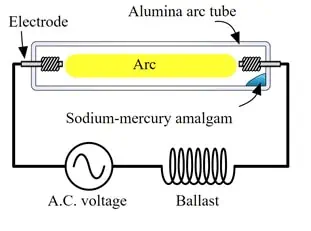
Pros & Cons Of High-pressure & Low-pressure Sodium
Sodium lamps are available in a wide range depending upon your use and the type of sodium lamp you want. High-pressure sodium vapor bulbs range from 35 to 1000 watts. At the same time, low-pressure sodium bulbs range from 35 to 180 watts.
Sodium vapor bulbs, indeed, take up some time to ignite. But low-pressure sodium lamps will get re-ignited quickly, eliminating the warm-up time. This happens mostly in times of interruption in the power supply. But still, they take a while to produce the usual luminance output. They have a low color rendering index. So it will be hard to distinguish colors, especially under LPS lamps. Sodium is a highly hazardous material that can explode when it comes in contact with air. So make sure you dispose of your old sodium vapor lamps properly.
Why High-pressure & Low-pressure Sodium- Key Advantages
High Efficacy
It’s interesting to know that even HPS and LPS can consume low power but not as low as LEDs. Efficacy is a technical term used to determine bulbs’ capability. We measure bulbs’ efficacy in lumens per watt, where LPS have high lumens than HPS. HPS has merely 150 lumens, while LPS can be up to 180 lumens.
Broad Lighting
The light spectrums of sodium bulbs get scattered when you turn them on. Therefore, these bulbs are best suited when you need a large and broad area to be lighted. They consume significantly less power to produce the desired output. In case of a high-pressure sodium bulb, it provides a wide spectrum of colors. The light emitted is more uniformly distributed than in other High-Intensity Discharge lamps.
Long Lasting
High efficacy leads to the long-lasting feature of an HPS bulb. They are more durable than most incandescent bulbs and high-intensity discharge lamps. You can assume that your LPS bulb can glow for more than 14,000 hours. And an HPS can glow for more than 24,000 hours.
Excellent Lumens Maintenance
Both low-pressure and high-pressure sodium lamps have high lumens maintenance, and there’s a slight decrease in the lumens output as the lamps age.
Minor Disadvantages Of LPS and HPS Bulbs
- The lights that HPS and LPS generate are not so good for the eyes. If you use these bulbs for a long time, you might experience headaches or eye redness. The researchers have resolved these problems in LED bulbs.
- Most people have switched to LEDs. If you’re still using sodium vapor bulbs, you might not find much stock in the market. Finding these bulbs in the market can become hectic.
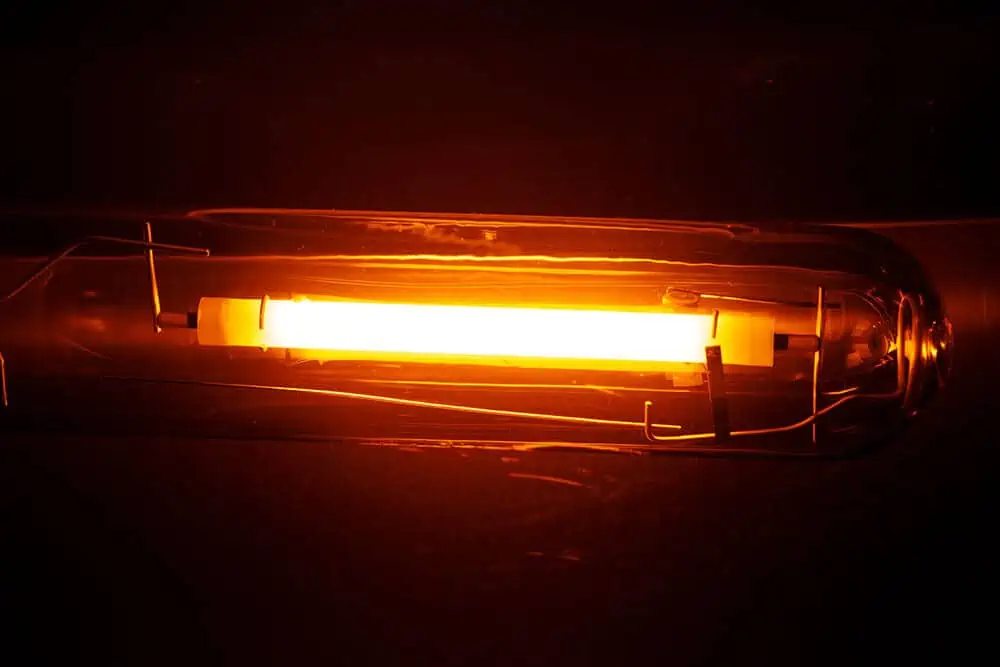
Applications Of LPS & HPS Lights
This section will teach you about the various applications of LPS and HPS lights.
- Street Lights
Sodium vapor lamps are widely used in outdoor lighting. They are mainly deployed in lighting public areas like parking lots and streets. These lamps are best for night-time lighting. Low-pressure sodium lamps can cover large streets to aid proper viewing since they emit scattered light rays. You’ll find LPS bulbs primarily on European streets. Unlike white lights, it is best for tunnel lighting, which comforts the drivers. These lamps are effective in providing illumination even during foggy and rainy seasons.
- Industrial Lighting
High-pressure sodium lamps provide lighting in industries and goods yards. They emit a broad spectrum of illumination covering 360°. They are also used in home yard lighting as they can be mounted anywhere and operated in any position. HDS lamps provide their maximum output at whatever positions they are mounted.
- Indoor Lights
HPS lamps are now used in indoor lighting like garages or warehouses. Some HPS lights are designed particularly for indoor use. The low-pressure sodium lamps are not used indoors as they produce only yellow light. Also, it is pretty hard to distinguish red, blue, and other colors. The monochromatic lighting gives a grayish shade to all the colors under LPS lamps.
- Advertisements
Advertisements need to be attractive. You can make an advertisement attractive by installing a lot of light bulbs around it. Therefore, sodium bulbs are used in advertisement boards.
Light Emitting Diodes Explained
LED is a way efficient semiconductor compared to LPS or HPS bulbs. LED is a p-n junction diode made up of a specialized semiconductor, and their high energy efficiency and long lifespan make them the best inductive lights.
LEDs emit through the electroluminescence principle. Upon receiving an electric current, the diode emits light. This is why they are called light-emitting diodes. These lights allow the electric current to pass through them only in the forward direction. When current is applied in the p-n junction, the electrons on one side move to the other, which lacks electrons.
Hence, with this continuous movement between the electrons, light is created. LEDs generally operate on low voltage. As the forward voltage increases, the intensity of the light will also increase. This makes the LEDs produce maximum illumination output.
LEDs come in an array of colors, such as yellow, green, white, blue, pink, and more. The light emitted varies according to the materials used in the semiconducting element.

Why LEDs- Key Advantages
- Long Life Span
Even though LEDs are more expensive than other light bulbs, they are worth the extra expense. They have an incredibly long life span of up to 50,000 hours. Expect LEDs to last 100,000+ hours. They are much more durable than other types of light bulbs. Moreover, you can expect them to last 4x more than LPS or HPS bulbs. This makes them the best choice in the long run.
- Low Maintenance
Almost all LED lights need less maintenance or sometimes no maintenance at all. They help you in saving your money, particularly on maintenance costs. The only expense you need to care about is the replacement cost of the bulbs. Replacement cost comes only after many years of usage. You don’t have to replace your light bulbs as frequently as other light bulbs.
- Excellent Energy Efficiency
LEDs are capable of operating at low temperatures producing less heat. So it never burns your fingers when you come in contact with the light bulb. There’s a strong technical reason why LEDs don’t become a burden on your electricity bill. Actually, the lumens of LEDs are used to generate a light spectrum. The lumens are used to convert electrical energy to light energy. Therefore, using good quality LEDs by good manufacturers is always recommended.
LED lights are ideal for domestic or commercial uses as they provide bright lighting at 180°. It may help you to get up to 70% improvement in overall energy efficiency. Replace any ordinary bulb with LED and achieve almost 90% more energy bills. These improvements contribute to your savings.
- Environment-Friendly
LEDs are environmentally friendly, unlike other traditional lamps emitting harmful rays. Emitting fewer UV rays, LEDs leave fewer carbon footprints than other light bulbs. LEDs are safe as they do not contain any toxic elements like mercury inside the bulb. Many fluorescent and sodium vapor lamps contain mercury inside them.
When these lamps reach the end of their lifespan, they must be disposed of safely, as they may catch fire when broken. In the case of LEDs, you don’t need to have special care in handling these light bulbs. They are safe to dispose of without the fear of combustion when exposed to air. Therefore, LEDs are favored for lighting in homes and offices.
- Provide High Light Quality
The bright light produced by LED bulbs is less irritating to your eyes. Light emitted looks more like natural light, similar to sunlight. LEDs have dimming capabilities which allow you to control the light’s brightness. This feature helps to increase their lifespan even more by consuming less energy. They are available in different qualities and watts according to your lighting requirements. LEDs provide high-quality illumination to your spaces operating under low voltage.
- Operate At Low Temperature
In cold conditions, most fluorescent bulbs require high voltage to start. They also produce comparatively less intensity of lighting than during average temperatures. But that’s not true in the case of LEDs; it is different. LEDs can work equally efficiently in cold conditions providing the same intensity light. Due to this reason, they are used in freezers and other cold storage spaces. People have started using LED lights for outdoor uses recently. LED lights are now deployed in public areas such as parking lots, streets, and airports. They provide high illumination throughout the night, even when the temperatures drop.
Minor Cons Of LEDs
LEDs do have some minor disadvantages or limitations that develop under certain circumstances.
- In some cases, LED bulbs fail and have a reduced lifespan when exposed to heat for a long time. This happens mostly when LEDs are used in outdoor lighting. In the street and public area lighting, the lamps are exposed to sunlight for several hours a day. However, this is a minor problem that can be quickly resolved.
- You may place the light bulbs under a lampshade, so it remains protected from the heat. You might have observed that LEDs are a bit costlier than halogens and other types of bulbs.
- LEDs are affordable for people from all sections of society at reasonable prices, but some people still find them expensive. Apart from the upfront expense, they sure will save money in the long run and make the extra expense worth it.

Applications Of LEDs
You can use LEDs in different situations because they generate less heat and more light. They are also cheaper to manufacture compared to other technologies. LEDs are available in many sizes, making them a better choice for many applications.
- Commercial Lighting
LEDs are widely used in offices and commercial buildings to provide maximum illumination. They help you have financial savings on energy bills with their low power consumption. In industries, LEDs are preferred for light emission in one direction. They don’t need any reflectors or diffusers to do so. LEDs provide high illumination of 180° in the direction where the light bulbs are mounted.
- Display Boards
LEDs are used in signboards, traffic lights, and billboards. They are chosen for this application due to their less power consumption and longer life. LEDs will be helpful in cases when the same display board has to show multiple languages. Local dimming can also be done by lowering the light output.
- Automotive industry
LEDs have overtaken halogen technology in the Automotive industry. LEDs are leading in this field with minimal power consumption and visual appeal. In 2004, Audi used LEDs for the first time in their cars as Daytime Running Lights (DRL). And it has become a massive hit since its introduction. LEDs gained popularity due to their smaller size, whiter illumination, and instant lighting.
- Lighting For Home
One of the widely used applications of LED light bulbs is domestic lighting. When compared to CFLs and Incandescent bulbs, LEDs are far better. They have the ability to change color because of the combination of red, green, and blue LEDs. They emit little heat and have a longer life. LED lights last almost 5 times better than CFL and 30 times longer than incandescent bulbs. They are also available in different shapes, sizes, and colors per your preference.
If you’re a homeowner, you might want to use LEDs. The key advantages of LEDs over sodium vapor bulbs make them the most preferred choice for homes. If you’ve got kids at home, go with LEDs, as they don’t use glass. Moreover, LEDs are available in so many attractive designs. Cute designs will help you decorate your home for a perfect quality of life. You can install fancy LEDs in your living room. Moreover, install colorful LEDs in your kids’ rooms. Your kids will definitely love it.
- Toy Manufacturing industry
In recent years, LEDs have become popular in the toy Manufacturing industry. A toy with LEDs can attract a kid more than one without LEDs. Most toys with LEDs are powered with the help of batteries to minimize the risk of electric shocks.
- Medical Applications
In surgical lights, LEDs provide better lighting with less heat emission. As these lights are much more durable, you need not replace them much often. Dentists prefer LEDs because they can move around and get a better look at affected areas. Another major medical application is in phototherapy. It is a type of treatment where LED lights are used to heal wounds faster.
- Digital watches
LED watches have become a trendy option for youngsters ever since their introduction. Consuming significantly less power, they keep the maximum accuracy in keeping time. LED watches use light nodes to light up the current time in the watch. Unlike mechanical watches, there are no moving parts in digital watches. With longer battery life, they need significantly less frequent maintenance.
- Flashlights
Flashlights are used in several domains, such as the army, defense, security guards, and during defense training. The main idea behind installing LEDs in flashlights is to get a long-lasting product. Moreover, LEDs will illuminate in one direction so that you can get a high beam of light from a flashlight. That makes flashlights ideal for rough and tough situations, such as in the jungle, woods, or in other similar regions.
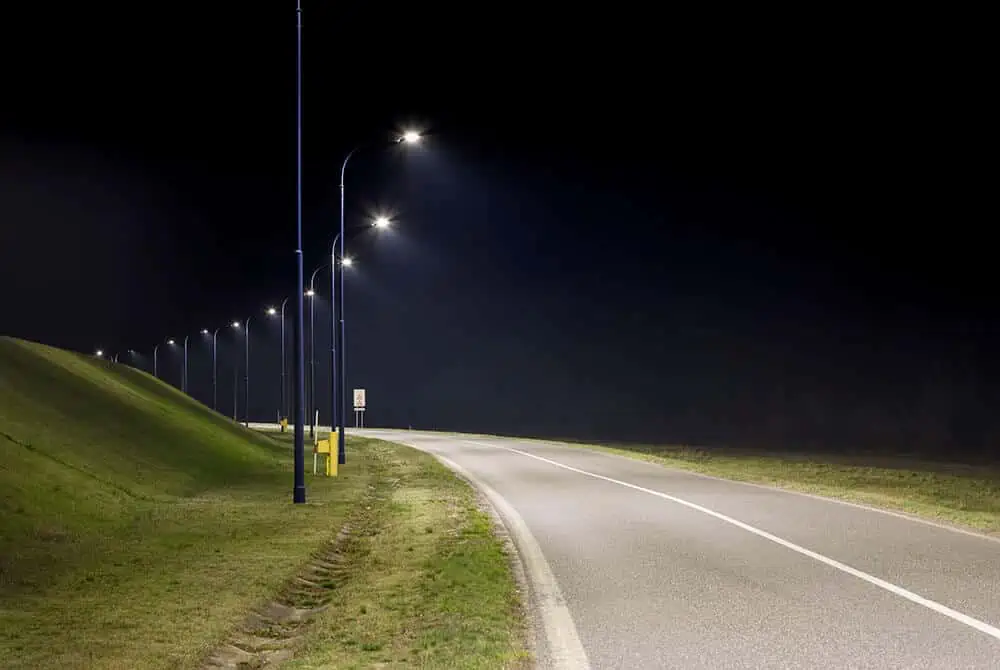
Comparing Sodium With LEDs
- Sodium lamps are omnidirectional, whereas LEDs are unidirectional. This means that sodium lamps produce high illumination in all directions. But LED lamps are capable of producing illumination only in a single direction.
- The lifespan of sodium lamps is much lower when compared to that of LEDs. The high-pressure sodium lamps have a lifespan ranging up to 18,000 operating hours. LPS lasts up to 24,000 hours. But when it comes to LEDs, you can expect them to last for more than 100,000 hours. This is considered the highest lifetime of any light bulbs that exist today.
- In LPS and HPS lamps, a relatively high voltage is provided to get the desired maximum output. LEDs require less voltage to produce the same lighting output.
- The LED light bulbs emit instant lighting as soon as they are switched on. Unlike sodium vapor lamps, it doesn’t require any warm-up time to produce illumination.
- LED lights have a high color rendering index of 80. The light emitted by LED bulbs seems more like natural light and looks closer to that of sunlight. On the contrary, sodium vapor bulbs emit a monochromatic yellow light. The light produced by LEDs is less sensitive to your eyes than sodium vapor lamps.
- The lifespan of sodium vapor lamps is not as consistent as LED bulbs. They tend to develop minor issues like flickering or dimming light after working for a few years. With LEDs, you will never have such problems. LED bulbs remain consistent for many years and are much more reliable than sodium lamps.

Are Sodium Vapors Depreciated?
Sodium vapor lamps were the most energy-efficient lamps that existed before LEDs. With a long-lasting life span, they produce high-intensity yellow light over a broad area. Low-pressure sodium lamps produce monochromatic bright yellow light. Under this yellow light, blue, green, and other colors appear gray.
This makes it difficult for people to distinguish different colors in this lighting. Be careful if you’re about to dispose of a sodium vapor bulb. These lamps are likely to cause combustion if sodium comes in contact with oxygen in the air. Hence, it is better if you break the sodium vapor lamp underwater so that it doesn’t get exposed to the air. After doing so, you can dispose of it somewhere safe.
LEDs provide bright light, which is similar to natural sunlight when illuminated. Unlike sodium lamps, this light is likely to cause less strain on your eyes. With high color rendering value, LED lights bring out the true tone of various colors. Under this lighting, you can easily distinguish between different colors. The components of LEDs are non-toxic and safe as they do not contain sodium or mercury gas inside the bulb. Owing to high efficiency with no maintenance cost, LEDs have become a sensible investment for your future.
LEDs are better than LPS and HPS lamps in many ways. Therefore, sodium vapor lamps have become obsolete with the entry of LEDs into the market. LEDs are trying to replace sodium lamps with their latest innovative technology. They have started taking over the applications of sodium lamps one by one.
LEDs Vs. Sodium Vapor Lights Comparison Table
| Factors Of Comparison | LEDs | Low-Pressure/ High-Pressure Sodium Lamps |
| Energy Efficiency | LEDs are the most energy-efficient light bulbs. They consume less energy to produce high-intensity light. | Sodium vapor lamps are not as energy efficient as LEDs. They consume high voltage to produce the same output. |
| Cost | Quite expensive when it comes to upfront costs. | Both types of sodium lamps are less expensive compared to LEDs. |
| Maintenance Cost | Low maintenance cost as LEDs does not require hardly any maintenance. | Maintenance cost is comparatively higher than LEDs as lamps require replacement over time. |
| Operate in Low Temperatures | Works well with efficiency without reduction in the intensity of the light produced. | Sodium lamps take more time to produce lighting with a decreased intensity. |
| Lighting Directions | Provide unidirectional lighting covering 180° and illuminating only in a single direction. | They give omnidirectional lighting and cover 360° to illuminate the entire area. |
| Consistent Lighting | LED lamps stay consistent for years without having to replace the light. | Sodium lamps are not very durable and tend to fail before reaching their lifespan. |
| Warm-up Time | No warm-up time is required as they provide instant lighting as soon as you switch on the light. | Require a specific warm-up period to provide high luminance output. In HPS, the warm-up time is between 3 to 5 minutes, whereas, in LPS, the warm-up time is between 5 to 15 minutes. |
| Life Span | The average lifespan is between 50,000 to 100,000 hours. | The lifespan of LPS is 12,000-18,000 hours. In HPS, the lifespan is up to 24,000 hours. |
| Disposal | Safe to dispose of anywhere without the need for special care. | Needs to be disposed of safely as these lamps may catch fire if they are broken. |
| Heat Emission | Emit less heat to produce a high luminance output. | Emit high heat to produce the same output. |
| Cycle Time | Instantly turns on and off without flickering. | Lamps start to flicker when they are turned on and off continuously. |
| Size | Available in different sizes from very small to larger sizes. | Available in different sizes but not as small as LEDs. |

Conclusion
From the comparisons mentioned above, it is evident that LED lights lead in every way. In terms of efficiency, lifespan, and many other factors, sodium lamps fail to keep up with LEDs. Therefore, LEDs are the way to go over the sodium lamps available today. They are becoming more versatile and affordable for larger sections of people nowadays.
LEDYi provides premium-quality LED strips and LED neon flex for indoors and outdoors. So, for linear lighting solutions, contact us soon!
